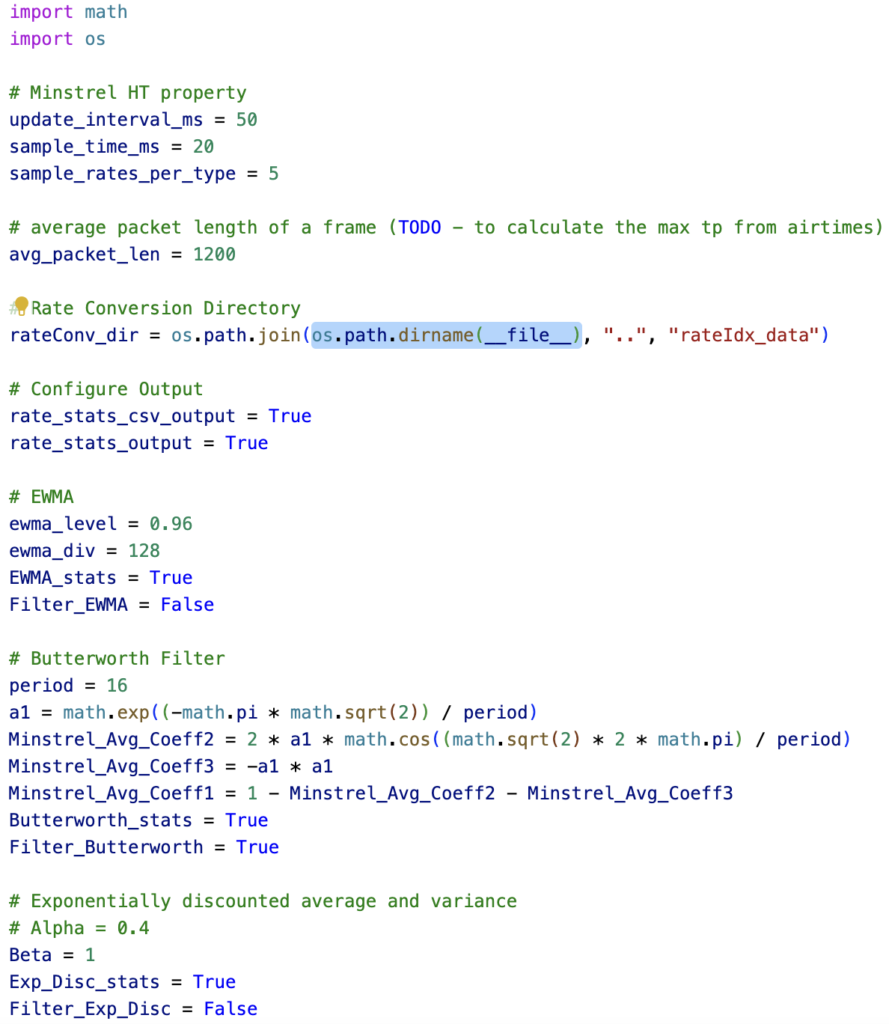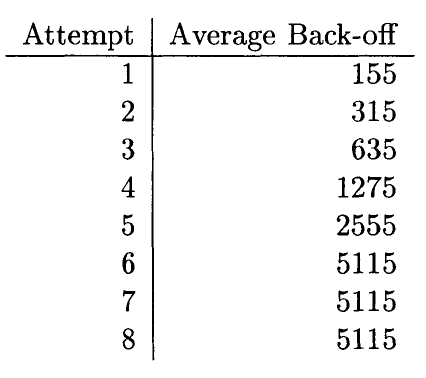Hi everyone! With the GSoC 2022 session almost coming to an end, this is my final blog post to share all of the accomplishments, conclusions, and outlook for the Minstrel TX Rate Control in user space.
Goals of the Project
- Adding a proper output to the existing user space Minstrel HT to aid in rate control analysis.
- Extending user space Minstrel HT with missing functions present in its kernel counterpart.
- Addition of new estimators/filters for research purposes.
- Proper documentation, demo, and guide on working with the Minstrel HT package.
All of the mentioned goals have been completed. Furthermore, there have been additional changes/improvements to the user space Minstrel HT that isn’t listed above. With this, the next sections will cover all of my contributions to the project followed by future work and limitations.
(1) New Output
Before GSoC ’22, the user space Minstrel HT didn’t have a proper output which wasn’t even easily interpretable. Furthermore, it wasn’t possible to run a script to analyze the performance of the user space Minstrel HT. Hence, I’ve replaced the old output which was simply a printout of the rate statistics dictionary with its own dedicated file and folder for each access point. For each access point and the physical WiFi chip, it creates two files: rc_stats and rc_stats_csv. The rc_stats is a human-readable output of the RateTable object for user convenience whereas the rc_stats_csv is a file that stores all the RateTable data throughout the execution of user space Minstrel HT for offline analysis.
The output has been previously discussed in the previous blog post with the screenshot of the outputs which can be found here.
(2) Addition of new functions from kernel Minstrel HT
The user space Minstrel HT has been extended with additional functionalities from the kernel Minstrel HT which was missing prior to GSoC ’22. Consequently, the user space Minstrel HT now, in terms of functionality, is closer to its kernel counterpart than before.
get_avg_ampdu_len: Calculates and returns the average AMPDU length for a station connected to the access point.
calc_retransmit: Previously, the retry count in the multi-rate retry chain was static and set to a specific value (10) for all the rates. With this new function, the user space Minstrel HT now dynamically computes the retry count for each rate in the rate setting.
check_sudden_death: Checks if the two best throughput rates have sudden packet loss and, if the packet count is greater than 30 with 75% loss, then the affected rate is downgraded.
prob_rate_reduce_streams: Tries to find a more robust rate index that uses fewer streams than the current maximum probability rate.
downgrade_rate: Reduces either the best or the second best throughput rate to the maximum group throughput rate from a lower group that uses fewer streams.
For the addition of these functionalities, the Python-WiFi-Manager package had to be extended to parse additional station information such as AMPDU length, AMPDU packet, and overhead for MCS and legacy rates.
(3) New Estimators
The user space Minstrel HT has been added with two new filters: Butterworth Filter and Exponentially Discounted Averaging and Variance. The kernel Minstrel HT no longer uses the Exponentially Weighted Moving Average (EWMA) and has switched to the Butterworth filter, however, prior to GSoC ’22, the user space Minstrel HT only had a simple implementation of the EWMA. The details on the Butterworth and the Discounted filter have been already discussed in my previous blog post which also includes the implemented mathematical formulas.
Regarding the EWMA, the previous implementation of the filter in user space Minstrel HT was also not identical to the kernel variant. Since the EWMA is used to calculate the average AMPDU length for a station, I’ve updated the implementation of the EWMA in the user space Minstrel HT and now consists of both EWMA level and division.
(4) Restructure
During the GSoC ’22 coding period, the WiFi-Manager package was restructured twice and, as the user space Minstrel HT is dependent on WiFi-Manager to perform kernel rate control functionalities, it was also modified to make the rate control algorithm compatible with the changes. Additionally, the user space Minstrel HT was also refactored to split the minstrel module into two modules: minstrel and sample module. Consequently, this enables each station to have an independent Sample object for probing which can be scaled and customized as needed in the future. Furthermore, the previous structure of user space Minstrel HT consisted of several independent loops which could have been avoided or merged to save computation time. Therefore, I’ve reduced the number of iterations in the minstrel module which has significantly reduced the computation time.
Previously, to obtain the best throughput rate and also the maximum probability rate, the user space Minstrel HT ran all the computations of finding the rates every time and was not stored to be accessed later. However, I’ve changed it such that, for an update interval, the best throughput rate and maximum probability rate are calculated only once and are available as an attribute of the RateTable object for direct access. Furthermore, I’ve also added a new attribute called “max_group_prob_rates” which stores the maximum probability for each group.
(5) Configuration
The user space Minstrel HT has been added with a configuration module to tweak filter parameters and rate control properties such as sample interval and update interval. The configuration file also allows the user to select the filter to be used for rate control. Currently, the user can choose from the following filters: Exponentially Weighted Moving Average (EWMA), Butterworth filter, and Exponentially Discounted Averaging and Variance.

The configuration parameters have been discussed in the previous blog post if this is in the interest of the reader. I have not included it here as this blog post is meant to only serve as an overview of all the changes and reiterating it here would only make the post longer.
(6) Rate-setting Experiment
Towards the end of GSoC ’22, I was also involved in conducting several experiments to validate the rate setting functionality in user space. For this, I created a separate GitHub repository with scripts to configure and run rate-setting experiments. The experiment script, for all supported rates, sets the rate between the client and access point, and after a rate-setting delay collects packet statistics for a specified time duration. The rate-setting delay and the time duration for rate statistics collection are completely configurable by the user. The output is stored in a file that shows, for each rate setting, the rates used, and their statistics.
For example, a WiFi connection with three supported rates could have the following experiment output:
| Setting Rate Index 00 |
| {’00’: {‘attempts’: 275927, ‘success’: 236525, ‘timestamp’: ’16d54c2156813120′}} |
| Setting Rate Index 01 |
| {’01’: {‘attempts’: 366064, ‘success’: 318634, ‘timestamp’: ’16d54c3dfcf4af70′}, ’00’: {‘attempts’: 1199, ‘success’: 584, ‘timestamp’: ’16d54c3cb7d445a0′}} |
| Setting Rate Index 40 |
| {’40’: {‘attempts’: 270312, ‘success’: 255716, ‘timestamp’: ’16d54deb84d2b0a0′}} |
The middle result would denote that after setting the rate between the connection to index ’01’, we still see that rate ’00’ was used where we would generally only expect to see ’01’.
(7) Sample Rate
The last thing that I worked on during GSoC ’22 was another prominent but older rate control algorithm, called Sample Rate, in user space. The Sample Rate algorithm was developed by John C. Bicket in 2005. Unlike Minstrel HT, Sample Rate is not time interval based but real-time packet-based rate control. In the beginning, the Sample Rate algorithm sets the rate index to the highest bit rate. If a rate index fails, then it switches to the next highest bit rate until it finds a rate that works. Every 10th packet, the algorithm samples a random bit rate that does not have four successive packet failures, and the lossless transmission time is less than the average transmission time of the current best rate.
The algorithm uses only the latest results that are not older than 10 seconds to determine the average transmission time for each bitrate. The best rate is the data rate with the lowest average transmission time per packet. The transmission time is calculated as follows:
tx_time(rate) = airtime(rate) + backoff_time(failed_packetes)
The average backoff time, in microseconds, for up to 8 attempts of a unicast packet is:

Where to find my work?
GitHub Repositories
- scnx-py-minstrel
- scnx-snippets/rate_setting_validation
- scnx-sample-rate
The repositories have not been public yet, but they will soon be released as open-source.
Future Work and Limitations
The user space Minstrel HT is running and fully functional but it has been only run on decent hardware i.e. laptop and not on embedded systems. It could be that the user space Minstrel HT requires heavy computation and may not be able to perform timely update intervals when running on an OpenWRT router itself. The output file, rc_stats_csv, file stores all the historical RateTable data which causes it to grow quite quickly and infeasible for experiment durations longer than several hours. Hence, a good addition to the user space Minstrel HT could be an in-built compression for the CSV file.
Furthermore, there are still some minor functionalities remaining to be implemented in the user space Minstrel HT. The kernel Minstrel HT uses a random sampling table to select probe rates which could be also implemented in the user space Minstrel HT as well instead of filtering from a list of potential probe rates. Additionally, now that the average AMPDU length can be calculated in user space Minstrel HT, the AMPDU length can be used to find the estimated throughput in an exact way as in the kernel variant.
The user space rate control API (minstrel-rcd) doesn’t have a way to set the retry count for RTS/CTS frames. Once this is implemented in the API, the calc_retransmit function in the user space Minstrel HT can be extended to compute and set the retry count for RTS/CTS frames as well. Similarly, the minstrel_ht_get_max_amsdu_len from the kernel Minstrel should also be implemented in the user space, in case it can be explicitly used which isn’t the case as of now.
Concluding Thoughts
The GSoC ’22 session has been a great opportunity to research and develop user space rate control algorithms. Even though, this is only the start of user space rate control algorithms, within the short time frame, a lot of work has been completed which has met and exceeded the initial goals. The Minstrel HT user space algorithm is now almost complete with all the functionalities from its kernel variant. Aditionally, another user space algorithm, Sample Rate, has also been implemented as a python package using the WiFi-Manager.
I would like to thank my mentor, Prof. Thomas Hühn for his time and guidance throughout the project. This was a fruitful experience and would love to see the future of rate control in user space.
One thought on “Final Report on Minstrel TX Rate Control in User space – GSoC ’22”